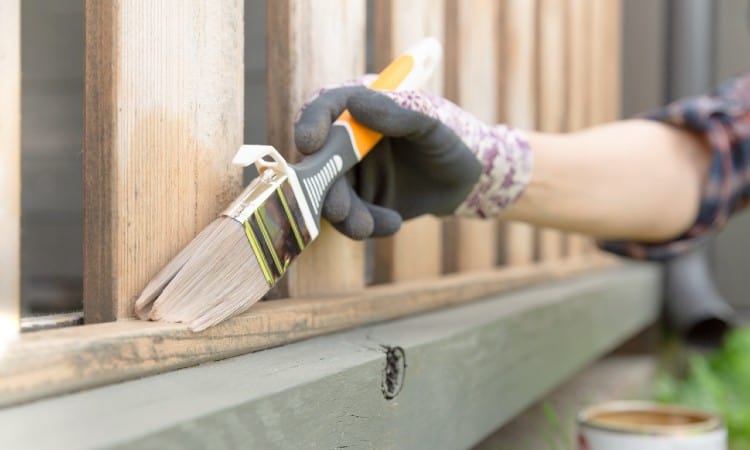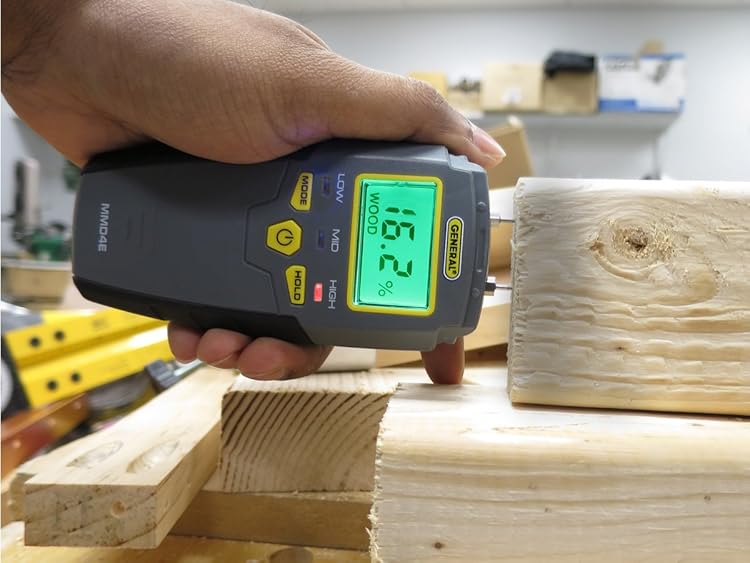How Long To Let Wood Dry Before Painting
You've blocked off your busy schedule so you can finally get that painting job done, merely, wouldn't y'all know it, the weather hasn't cooperated. A storm the night before has left your weekend project damp. You know, waiting for the wood to dry is the best path forward, but there's no fourth dimension for that. The job needs to get done today. Can you pigment wet wood?
Although information technology's non recommended, yous can paint wet forest. By incorporating a few tricks to aid speed the drying procedure and by using the right materials, yous tin can still stop up with a quality finished product.

Tin You Pigment Wet Wood?
The brusque answer to this question is "yes." But first, let's talk over why you lot might not desire to.
While it is possible to pigment moisture wood, at that place are a host of reasons why y'all should look for it to fully dry out, each of which you should advisedly consider earlier making that first stroke with the paintbrush.
Permit'southward begin past discussing what happens to wood when it rains. When wood is moisture, some pct of the wood fibers absorb water. That means there are fewer forest fibers free to absorb paint. This tin crusade several problems.
Kickoff, if the woods is very saturated, the application will be sloppy. As you employ the pigment, it will stay on the surface of the wood, creating a sloppy looking finish that will quickly peel away one time dry.
If at that place is a significant corporeality of wet in the wood, it may mix with the paint, thinning it. This will event in poorer coverage and more than runs and drips. Once it dries, you may terminate up with more than of a wash than a paint job.
Fifty-fifty wood that is just moderately clammy won't be able to absorb the paint as deeply as dry wood. This means the finish will be less durable. A pigment job that should concluding 10 years may brainstorm peeling in just ii or three.
There are other bug to consider as well. Painting wet wood tin can consequence in unsightly bubbles caused by the paint mixing with the moisture in the wood.
Finally, painting wet woods also increases the chances of rot. Paint creates a waterproof seal effectually woods.
In the case of dry wood, this is a benefit, as information technology prevents moisture from reaching the wood.
This barrier creates a problem with wet wood. If the wood is clammy, the paint volition trap the wet in the wood, preventing it from drying. That trapped moisture will somewhen crusade the wood to rot from the inside out.
With all of the potential hazards of painting wet wood, it makes sense to look for the wood to dry. The durability of your pigment chore is significantly reduced when the wood is moisture.
And yet, sometimes, you just don't accept a option. If that's the case, so you need to use techniques that volition help to minimize the bug described above.
How to Paint Wet Forest
It is possible to pigment wet woods and get a quality terminate by post-obit some elementary guidelines and employing a few tricks. You'll need to dry the wood, use a high-quality paintbrush, and buy the right paint to consummate a paint job that will endure.
How Long to Allow Wood Dry out Before Painting
Ideally, y'all want the wood to dry out for at least a day after existence saturated, depending on the weather. Moisture wood will dry quickly in the dominicus or in a depression humidity environment. Forest in shaded areas or a more than humid climate will take longer to dry.
If y'all can't afford to expect the requisite corporeality of fourth dimension for the woods to dry earlier you start painting, you'll need to speed the drying procedure upwardly.
How to Dry Wet Wood Before Painting
In that location are a variety of artistic techniques you tin can use to aid speed the drying procedure along.
One of those methods is to use a hairdryer to dry the wood. Merely turn the hairdryer on loftier and blow warm air over the wood. Every bit with your pilus, the air will cause the wet in the wood to evaporate, drying the wood.
This procedure makes more sense if you lot're attempting to dry out a relatively small amount of forest. Using a hairdryer to dry, say, an entire fence or deck doesn't make a lot of sense.
One strategy for larger projects would exist to dry out and paint surfaces in small sections, slowly working your mode through the unabridged project. But, over again, this may exist more time consuming than information technology's worth. And, you lot may burn out your wife'due south hairdryer in the process, compounding your problems.
Another option is to apply paper towels or an old towel to dry the surface of the wood. This won't piece of work quite every bit well as the hairdryer method as information technology volition only absorb water on the wood's surface. Information technology will, however, help prepare the surface to receive paint and presents a faster solution than the blowdryer.
For smaller projects, y'all might as well consider using an electric fan to dry out out the wood. But gear up up the fan and accept information technology blow air direct on the wood, speeding up the drying process.
If you tin motility your project indoors, try using a dehumidifier to pull the moisture out of the forest.
If yous're working with loose building textile and looking for the quickest way to dry information technology, consider stacking the boards using scrap lumber or furring strips that create gaps between the boards, assuasive for airflow that will dry the lumber.
Whichever strategy yous use to dry the forest, proceed in heed that none of these tin can replace the best method: time. While these drying tricks volition aid take some of the moisture out of the wood, they are unlikely to completely dry out out the wood. The best method is withal simply to wait and allow the wood to dry out on its own.
How to Tell If Woods Is Dry out Enough to Paint?

After employing i or more of these drying strategies, y'all might find yourself wondering only how successful your efforts have been.
It's often hard to tell just how dry the woods is and whether it's paintable or not. Sometimes the outside may appear dry out while the interior is saturated. In that location are a few things to consider when trying to decide if the wood is dry enough to pigment.
How exposed is the wood to the weather condition? An uncovered deck might be saturated by a storm while siding that is protected past eaves may only be a picayune damp.
Also, consider the dominicus. A West-facing wall may receive hot afternoon sun and dry out rapidly while a Due north-facing wall may not receive much directly sunlight at all and therefore take significantly longer to dry.
Rainwater also affects wood differently than power washing, a mutual pretreatment to painting home exteriors and decks.
Due to the high pressure involved, power washing will typically crusade woods to go more saturated than a rainstorm. Power washing forces h2o into the cracks and crevices in siding or a deck that may not usually be reached by falling pelting. These nooks and crannies could take significantly longer to dry than areas that are more exposed.
 The bead test is too a good way of determining if the wood is besides wet to pigment. Sprinkle some water on the wood. If information technology beads up, it means the fibers in the wood are resisting the water considering they are already saturated with moisture. If this is the instance, then the wood won't easily accept pigment.
The bead test is too a good way of determining if the wood is besides wet to pigment. Sprinkle some water on the wood. If information technology beads up, it means the fibers in the wood are resisting the water considering they are already saturated with moisture. If this is the instance, then the wood won't easily accept pigment.
If you lot're looking for something a footling more scientific, consider investing in a moisture meter. Moisture meters, which are fairly inexpensive, tell you the percentage of moisture content in the wood. Simply press the meter's prongs into the wood, push a push, and read the wet content. The moisture content of 16% is the upper limit for most paints.
What Paint Type Works Best for Damp Wood?
1 of the almost important factors to consider when painting forest is the blazon of paint you're using. Since you'll be applying the paint to wood that is to some degree saturated with water, you'll want to use latex paint.
Latex paint is water-based, meaning it will better bond with the moisture in the wood. This reduces the chances that the pigment will skin.
If you lot're familiar with the idiom "they mix like oil and water," so you lot know why you shouldn't use oil-based paint to glaze clammy wood. Oil resists h2o. This means oil-based pigment will not bond with the moisture present in the wood. The effect is paint that volition eventually peel away from the forest.
You should besides consider the blazon of castor yous're using to apply the paint. Since a cream brush holds less pigment so a bristle castor, you'll be able to utilise a thinner and more even coat.
This is important since you will be applying paint onto damp wood that volition not soak up as much paint as dry wood. Applying too much paint at a time to wet forest tin can result in a mess. A cream brush will help yous to meliorate regulate the corporeality of paint you're applying with each stroke.
Decision
In a perfect earth, when confronted with wet siding or a sodden deck, yous'd be able to wait the requisite number of days for the wood to fully dry out earlier applying paint. But, as we all know, one doesn't always have the fourth dimension to expect for Mother Nature's cooperation.
While y'all may not get the same durable paint cease equally y'all would with a dry out surface, past using some unproblematic preparation techniques and the proper materials, y'all can still execute a quality paint job on moisture wood.
Source: https://painttopics.com/can-you-paint-wet-wood/
Posted by: kiferfrimply.blogspot.com


0 Response to "How Long To Let Wood Dry Before Painting"
Post a Comment